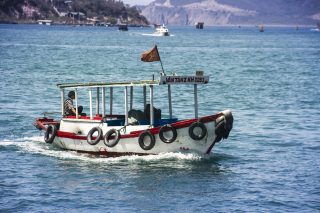
Verdant mountains embroider a necklace that surrounds the half-moon shaped beach of Nha Trang, where R/V Falkor awaits her next expedition.
Life everywhere is dependent on the ocean’s health, but this reality is quite apparent here. Tourism is the backbone of the local industry in this coastal city with sandy beaches, a seabed dotted with diverse corals and a turquoise bay rich in fisheries and seafood.
The atmosphere inside R/V Falkor agrees with fast-paced Nha Trang. There are no curfews like in other Vietnamese cities; here excitement and energy linger in the air. Whereas ashore tourists are more concerned with maximising their vacations and packing their passports and cameras, onboard R/V Falkor the scientists and crew go through a much more complex checklist.
Back at the aft, a crane tirelessly unloads containers, while biochemists, oceanographers and biologists make sure every piece of equipment comes into place and is accounted for. In the library, Chief Scientist Joseph Montoya meets with his team to paint the last strokes on the work plan and water budget – everybody here needs a share of the seawater that will be collected! – while, up on the bridge, R/V Falkor’s officers confirm everyone onboard is familiar with the ship’s procedures and the vessel is ready for three weeks of intense research.
Following in Cuu Long’s Tracks

The 12th longest river in the world has summoned us here. It is born in China, and after flowing through Myanmar, Laos, Thailand and Cambodia, the Mekong River arrives in Vietnam and merges with the South China Sea. When it joins, it does not come alone but is escorted by all sorts of human-induced modifications.
The Vietnamese call it Cuu Long – ‘Nine Dragons’ – because in the delta the river splits into many branches. The dragons have been awakened by the intense rainfall of the imminent monsoon, so they have been pouring furiously into the ocean. Meanwhile, strong winds push the upper layers of ocean water away, causing an upwelling of deep, nutrient-rich waters.
This scenario provides an excellent opportunity to explore and distinguish the role of riverine inputs, with their human-induced modifications, and ocean circulation in controlling productivity in a tropical coastal marine ecosystem. “What is really interesting is that our area of study cuts right through the Mekong river’s plume, and we know that there is already a strong upwelling taking place, so we will be right there to create a baseline and come back after the monsoon to compare the changes,” says Maren Voss, here to study stable isotope biogeochemistry and nutrient cycling.
How to Unravel a Dragon
Identifying the aftermath of the Mekong’s fierce entrance into the ocean and disentangling where every factor comes from is by no means an easy task. So maybe it is fitting that another dragon has risen to the occasion – A Luck Dragon: The scientific party will take advantage of every research capability R/V Falkor has to offer.
First, researchers will analyze both the ocean upwelling and the riverine flow during the critical monsoon period. Then they will measure water fluxes and explore the physical, chemical and biological factors affecting the transport and transformation of nutrients in the South China Sea. Finally, the team will implement a physical/biological model to explore the evolution of the nutrients over time.
Life everywhere is dependent on the ocean’s health, and as humanity alters the ocean’s systems, it may reshape our entire future. When the sun rises again over frenetic Nha Trang, R/V Falkor will sail to meet a unique opportunity, studying the role of land-ocean connectivity in an attempt to shed some light over what that future might be.

